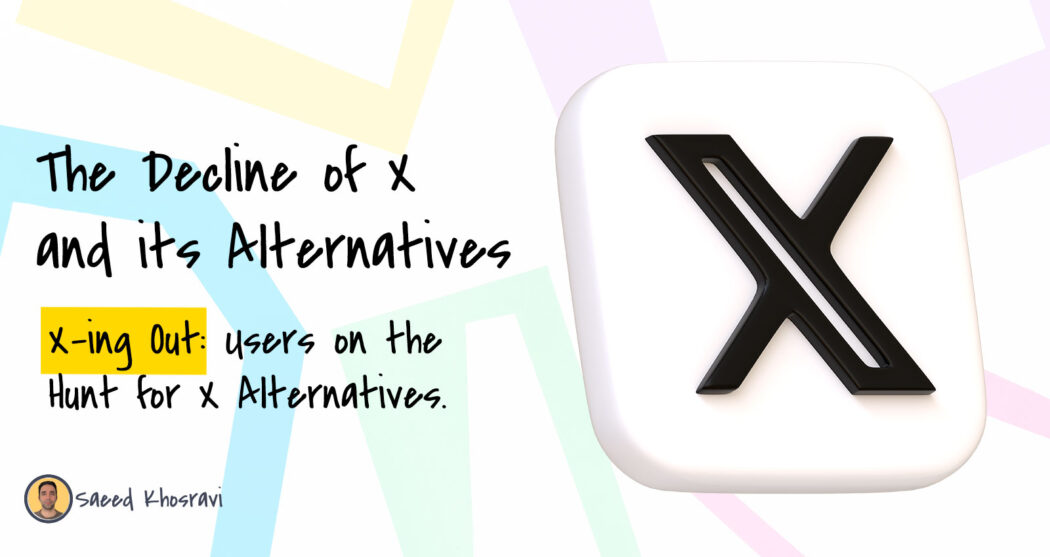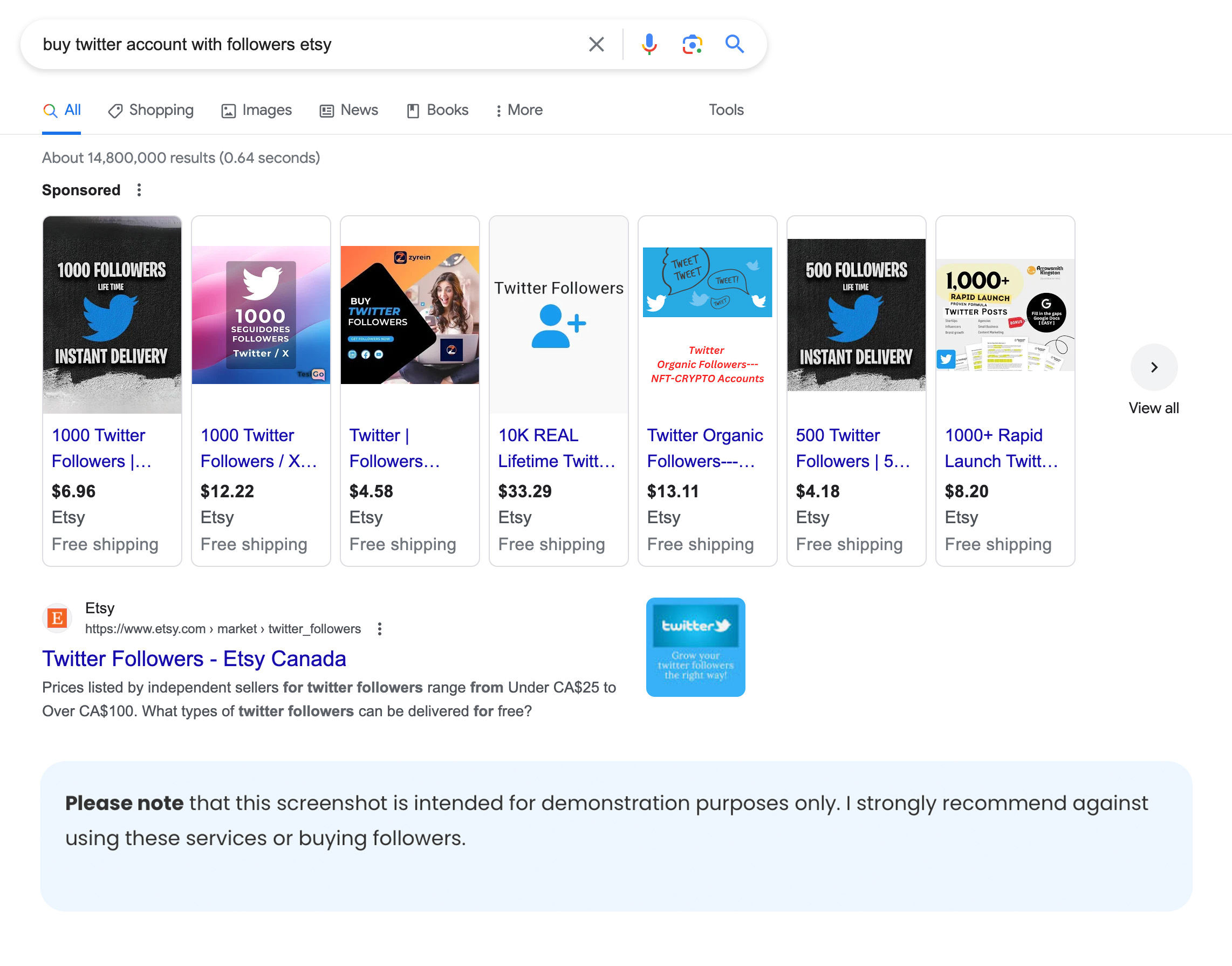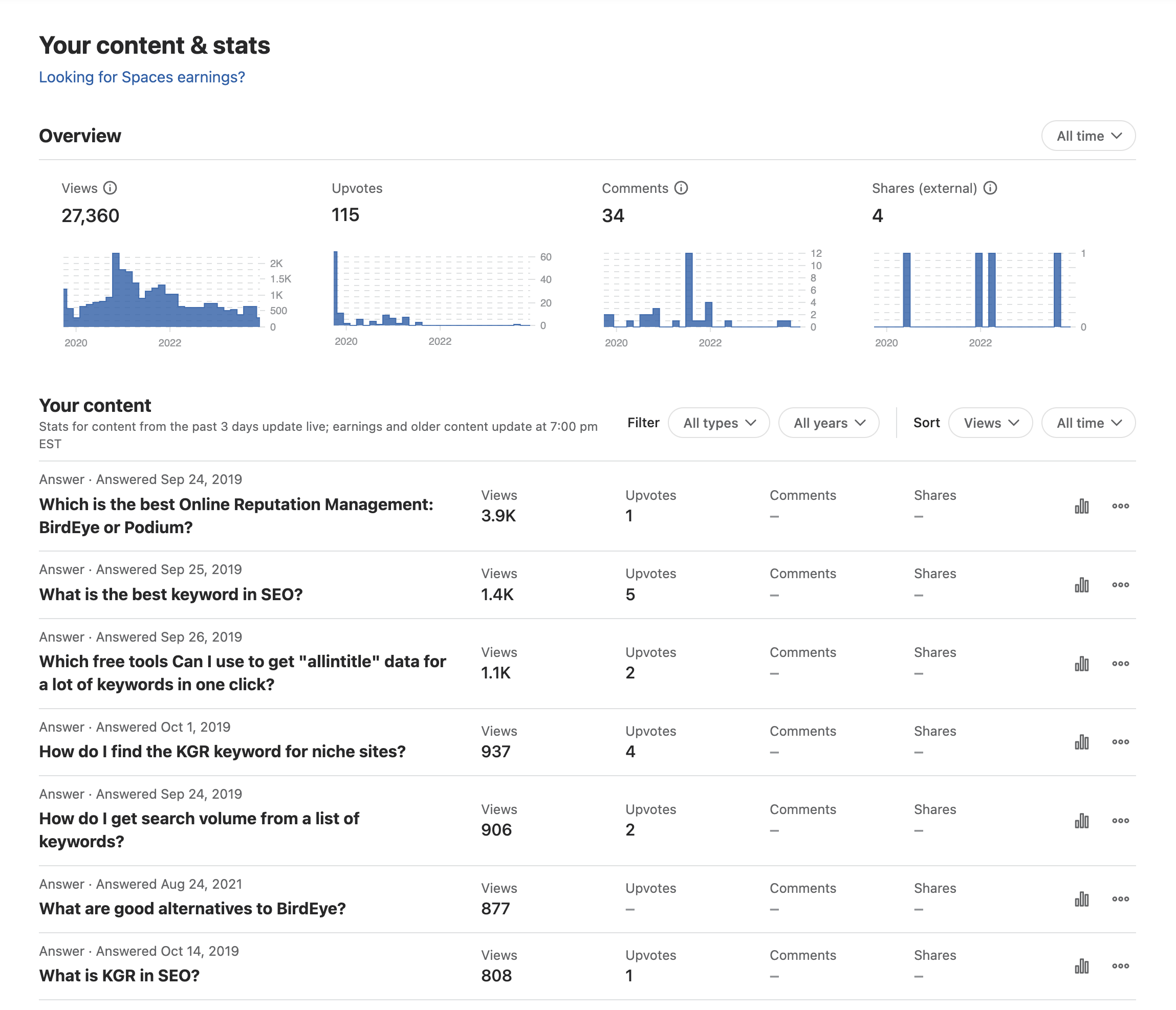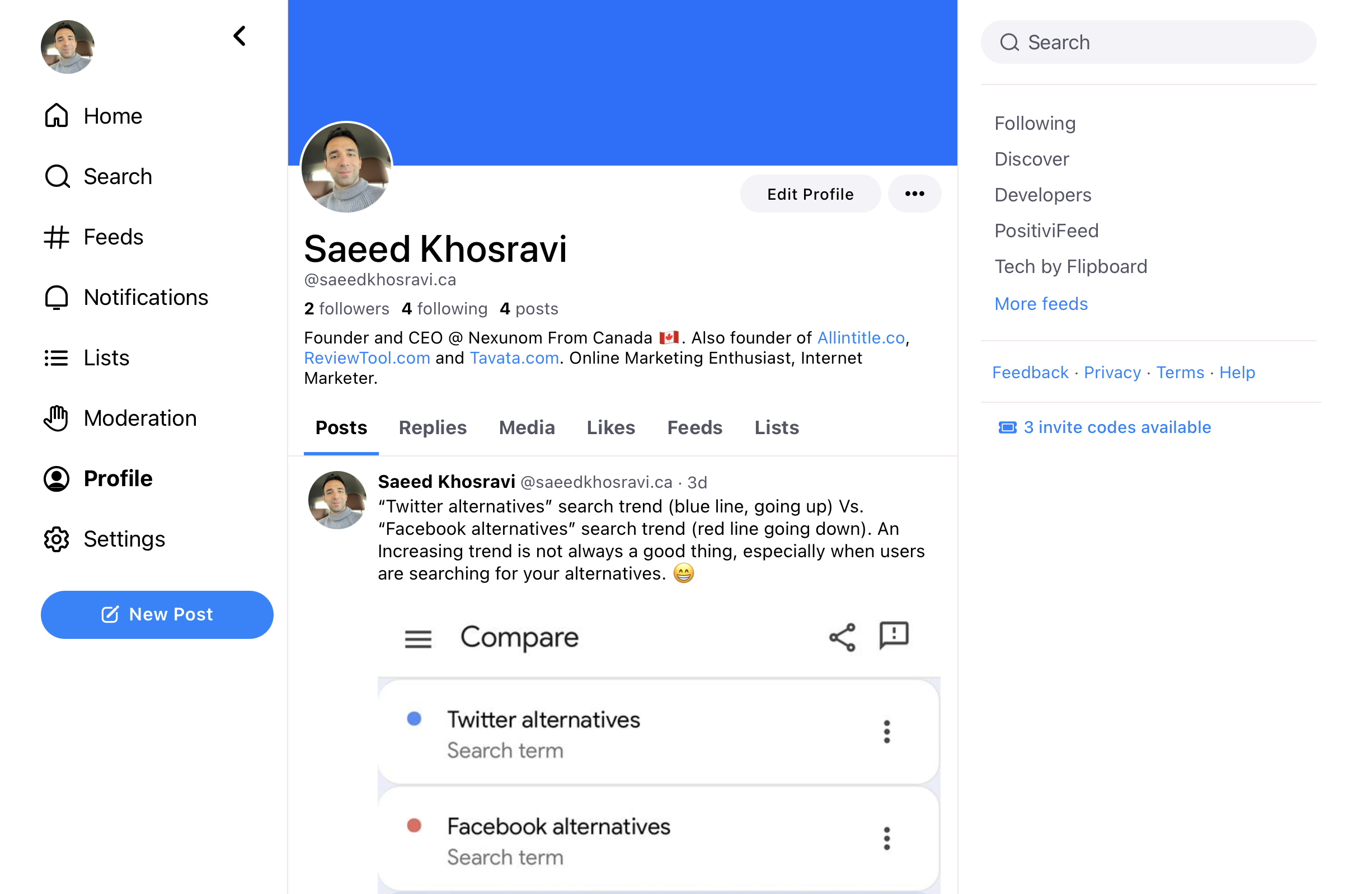As a digital marketer and a keen observer of social media trends, I’ve experienced firsthand the ups and downs of various platforms. My journey with Twitter, especially during its recent phase as X, has been particularly eye-opening. In this post, I’ll share my personal experiences with X’s decline and explore some promising alternatives, particularly the decentralized ones, to this once-great platform. The problems and issues I’ve listed in this blog post are not unique to my experience with X. Preparing this blog post, I’ve come across many stories and similar experiences with X, a trend that I believe has led a lot of users to “press X to Exit” the X platform — a phenomenon that I refer to as “X-ing Out” in this blog post. Let’s take a look at the table of contents first:
Table of Contents
Organic Traffic Does Not Equal Platform Quality
While Elon Musk may have reasons to be proud of Twitter’s high organic search visibility — which, let’s be clear, doesn’t necessarily equate to the quality of user engagement or the robustness of their platform or their support — a quick glance at Google Trends shows that searches for “Twitter alternatives” have seen a notable uptick, standing out even more against the declining interest in “Facebook alternatives.” This trend could very well reflect growing user dissatisfaction with Twitter. Despite Twitter’s prominent placement in Google’s search engine results pages, possibly due to existing agreements, the surge in searches for alternatives clearly shows the current sentiment towards the platform. It’s an indicator that users are actively seeking out other avenues for social media engagement, thus X-ing out, perhaps driven by the desire for platforms that offer better experiences and support. Here is my LinkedIn post about this rise of the “Twitter Alternatives” search:
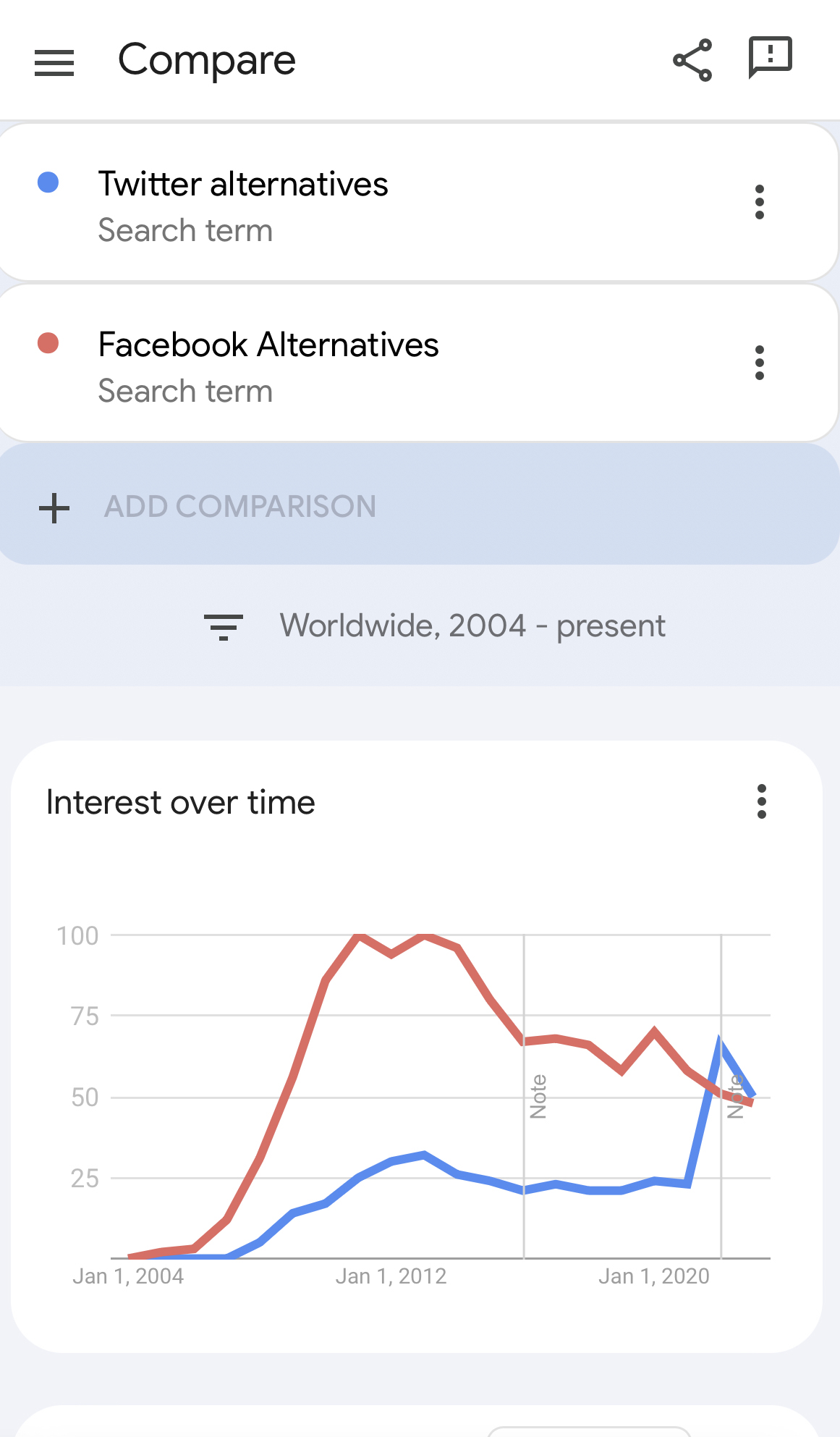
Twitter’s Overactive, Inaccurate Suspension Bot
One of the most frustrating aspects of Twitter’s platform is the overzealous spam detection bot. It’s like a digital dragnet that sometimes catches the wrong fish. For instance, if someone named John Doe breaks the rules and gets flagged, the bot might go overboard and suspend one or two other John Does it comes across. This guilt-by-association error leaves innocent users scratching their heads and scrambling to reclaim their digital identities.
But the bot’s missteps don’t end there. It often acts on user reports with a hasty response, immediately suspending accounts without any real person checking to see if the reports are legit. Imagine you’re minding your own business on the platform, and boom — you’re locked out because someone decided to report your account, possibly out of spite or competition.
To make matters worse, if you find yourself caught in this situation, good luck getting help. The support system can feel like a cold, automated maze. Any appeal request will only result in an immediate automated response that basically says, “Your account was suspended due to violations of our Terms of Service. After reviewing for reinstatement your account will not be restored” as shown in the image below. The question is how could they review it, just seconds after you request it? This dismissive approach can leave users feeling powerless and alienated — the very people who help keep the platform alive.

Twitter Weaknesses
Twitter, now known as X, was a game-changer in its heyday. But despite Elon Musk’s efforts, it’s become a shadow of its former self. Here’s why:
- Bots and Fake Accounts: Twitter’s riddled with fake accounts. I’ve seen Twitter accounts with 10K followers being sold for $20 on Etsy. This raises serious doubts about the authenticity of its user base.
- Arbitrary Account Suspensions: Legitimate accounts are suspended without clear reasons. Sometimes, you get a vague email about violating rules, but often, there’s no explanation at all.
- A Buggy Platform: Both the app and web version are plagued with glitches. It’s surprising that such a widely used platform can’t provide a smooth user experience.
- Weak Support System: The appeal process is a joke. You submit a form and immediately get a canned response saying your account can’t be reinstated. No real support, just automated replies.
- A Haven for Negativity: Haters and bullies seem to overrun Twitter, especially if you dare to run an ad. I’ve faced irrelevant political, off-topic, nonsensical comments, and outright hostility in my ad campaigns (an ad campaign that was promoting my free keyword finder tool, which is a free version of our Allintitle.co KW Explorer.)
I Got Suspended Twice For No Reason
I’ve had my account suspended twice for no apparent reason. The first suspension was lifted after a few days and claimed to be a “bot error,” as can be seen in the email below:
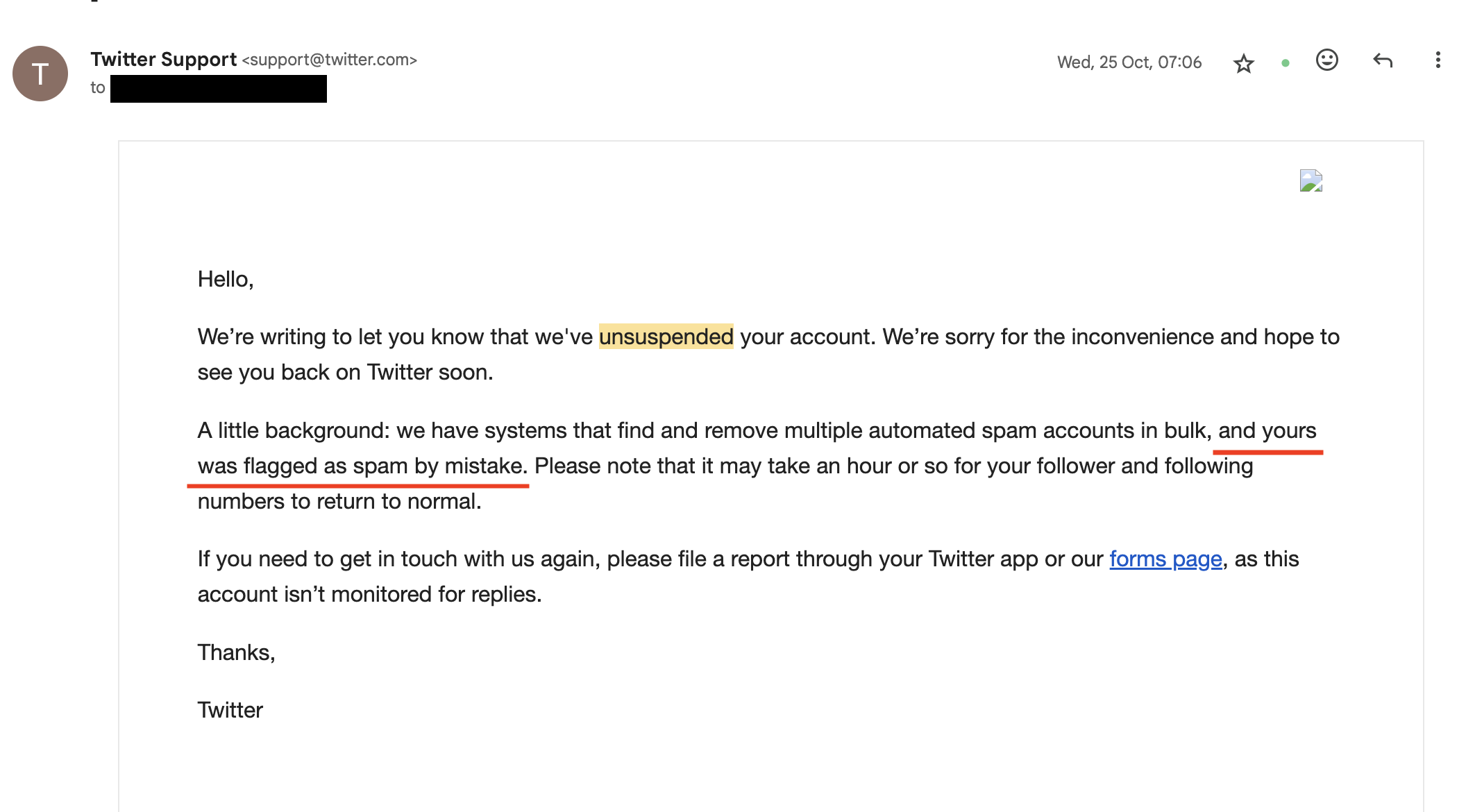
Here are the two posts I added to LinkedIn about the two suspension incidents:
The second time, I was accused of violating rules based on a user report, as shown in the screenshot of the notification email below. But I hadn’t done anything wrong:
- No mass activities or engagement with sensitive content (I didn’t like, post, or comment any sensitive material or on any sensitive post. I also didn’t message anyone.)
- I only posted regular stuff about SEO, WordPress, etc., and promoted our Allintitle Free Keyword Research Tool.

A competitor or hater likely reported me, leading to an unjust suspension. This shows that no one from Twitter has at least looked at my Twitter activities to see if the report has been genuine and if there are any violations of their rules before actually suspending the account. This experience isn’t unique; many users have faced similar issues. You can read similar stories by just searching “Twitter Suspension without Reason” on Google.
The Illusion of an Appeal
Appealing a Twitter suspension is futile. The process is automated and impersonal, nobody is going to actually look into your account activities to see if the user report or the bot flag was based on an actual violation of the Twitter guidelines or is just baseless. The Appeal Request form results in an immediate automated response like the one in the image below:
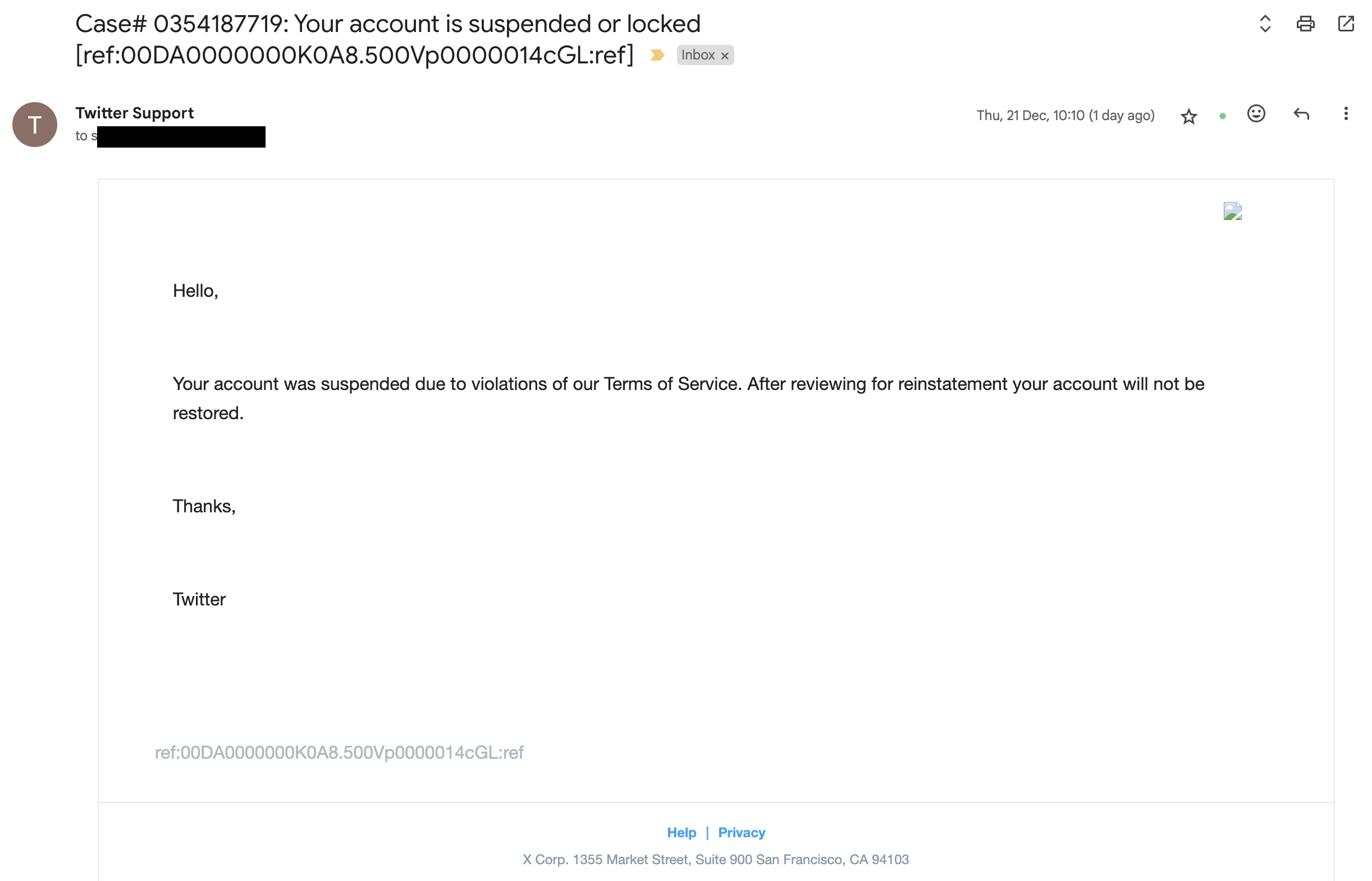
The Risk of Running Ads on Twitter
Ironically, running ads on Twitter can increase your risk of suspension. Your ads, exposed to a wide audience, may attract baseless reports, resulting in suspension. This undermines the platform’s user support. Below, I am sharing the screenshot of the Ad I was running on Twitter/X:
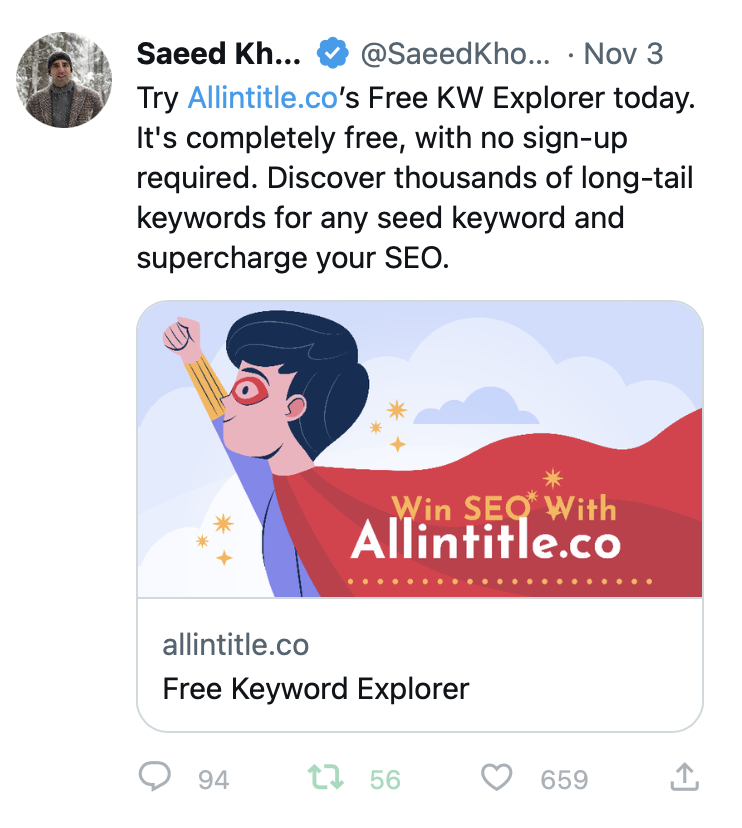
The Risk of Shared Names on Twitter
On Twitter, having the same name as someone involved in rule-breaking activities can inadvertently put you at risk of account suspension. If you’re more prominent and therefore appear first in search results, you could be wrongly reported and penalized due to someone else’s actions, simply because of a shared name.
Seeking Alternatives: Beyond Twitter
Frustrated with Twitter’s issues, I’ve looked into other platforms:
- Meta (Facebook/Instagram): Offers controlled, visually engaging experiences.
- Tumblr: A creative space for artists, writers, and fandoms.
- Reddit: Ideal for niche interests and deep discussions.
- LinkedIn: The premier platform for professional connections and content sharing.
- Quora: A Q&A platform rich with expert insights across various topics.
- BlueSky: Reminiscent of Twitter but with a user-centric, decentralized approach.
- Mastodon: A decentralized, open-source platform with a community-driven environment.
- Threads: Encourages in-depth conversations, integrated with Instagram for a familiar yet enhanced experience.
What Makes a Social Media Site Great?
When we talk about a great social media site, a bunch of things come to mind. Let’s break it down:
- User Experience (UX): It’s all about how easy and fun it is to use the site. Fast, clear, and crash-free is the way to go.
- User Engagement: We want a platform where sharing, chatting, and reacting feels good and keeps us coming back.
- Content Quality: No one likes fake news or spammy posts. Good platforms keep it real and relevant.
- Privacy and Security: Our data needs to be safe, with no ifs or buts.
- Algorithm Transparency: Ever wonder why you see what you see on your feed? We should know how it works.
- Supportive Community: A place where positivity and creativity thrive is where we want to be.
- Customer Support: Got a problem? The platform should be there to help, fast.
- Moderation and Safety: Keeping things respectful and safe without killing free speech is key.
- Adaptability and Innovation: Keeping up with what’s new and cool keeps things interesting.
- Platform Policies: Clear rules mean everyone knows what’s okay and what’s not.
- Feature Set: More features, more fun. We’re talking media, live streaming, stories, and more.
- Accessibility: Everyone should be able to get in on the action, no matter their abilities.
- Cross-Platform Compatibility: On your phone, tablet, or laptop – it should work everywhere.
- Monetization Opportunities: For those looking to make some cash, this is a biggie.
- Cultural Sensitivity: Respecting different cultures makes for a global, inclusive community.
Traditional Alternatives
- Meta (Facebook, Instagram, WhatsApp, and Threads): Meta’s platforms offer a richer and more nuanced social experience than Twitter. Facebook’s expansive features allow for deeper connections and more detailed sharing, while Instagram’s focus on visuals and storytelling provides a creative outlet that Twitter’s text-limited format can’t match. Twitter’s brevity has its charm, but Meta’s platforms win for those seeking depth and variety. Meta also outshines Twitter with more reliable support and a sharper moderation team.
- Tumblr: Tumblr offers a personalized space for creativity that Twitter’s uniform format lacks. It’s where your blog can really reflect “you.” Tumblr’s platform allows for a mix of content forms, fostering a unique and inclusive community of artists and writers. While Twitter is great for quick updates, Tumblr is the go-to for in-depth, personal expression.
- Reddit: Reddit is like a world of focused forums, offering in-depth discussions on specific topics, a contrast to Twitter’s broad and general feed. Reddit’s structure encourages deep dives into hobbies and interests, while Twitter excels at delivering quick, real-time updates. If you’re looking for detailed community engagement, Reddit’s the place.
- LinkedIn: LinkedIn stands out as the professional networking hub, focusing on career growth and business connections, unlike Twitter’s general social networking approach. LinkedIn’s platform is tailored for showcasing professional achievements and building business relationships, offering a more career-oriented experience than Twitter.
In the infographic table below, I compare the functionalities and features of Twitter with those of other prominent social media platforms mentioned above:
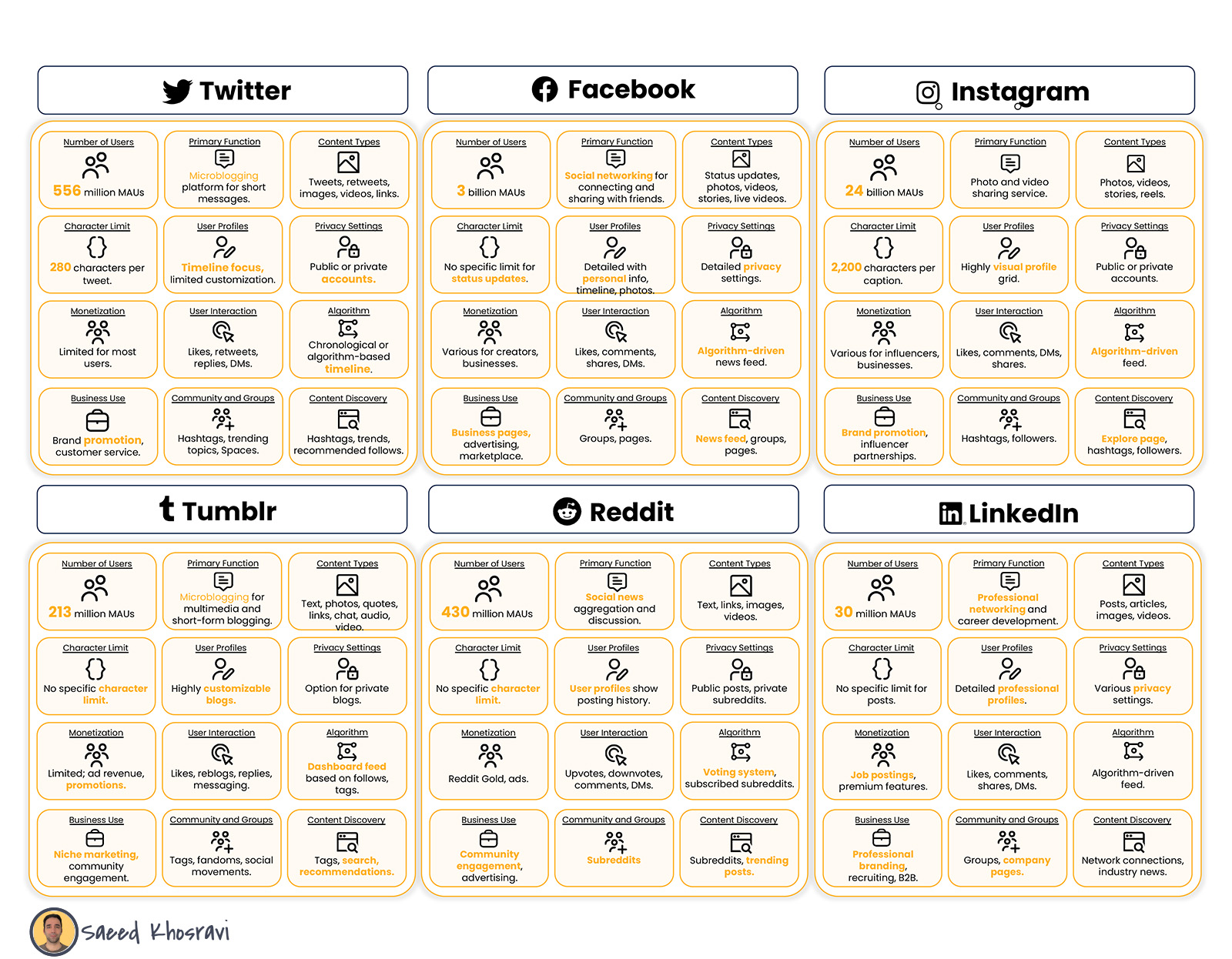
In the following table, you can see a more detailed comparison of Twitter’s top alternatives:
| Feature | Tumblr | |||||
|---|---|---|---|---|---|---|
| Number of Users | ~ 556 million MAUs1 | ~ 3 billion MAUs | ~ 2.4 billion MAUs | ~ 213 million MAUs | ~ 430 million MAUs | ~ 310 million MAUs |
| Primary Function | Microblogging platform focusing on short messages, known as tweets. | Social networking site for connecting with friends, sharing updates, photos, and joining groups. | Photo and video sharing social networking service. | Microblogging and social networking platform focused on multimedia and short-form blogging. | Social news aggregation, web content rating, and discussion website. | Professional networking site, focusing on career development, professional connections, and industry news. |
| Content Types | Tweets, retweets, images, videos, and links. Hashtags are widely used. | Status updates, photos, videos, links, stories, live videos. Groups and pages for specific interests or organizations. | Primarily focused on visual content: photos and videos. Text is secondary, used in captions and comments. | Various post types including text, photos, quotes, links, chat, audio, and video. Emphasis on reblogging and liking posts. | Posts can be text, links, images, or videos. Content is organized into “subreddits” on specific topics. | Posts, articles, images, videos, and professional updates. Emphasis on career and business-related content. |
| Character Limit | 280 characters per tweet. | No specific limit for status updates, allowing for longer posts. | Caption limit of 2,200 characters per post. | No specific character limit for posts, allowing for longer text entries. | No specific character limit for posts; supports long-form text in posts and comments. | No specific character limit for standard posts, but longer-form articles can be published. |
| User Profiles | Focus on the timeline of tweets. Profile customization is limited. | Detailed profiles with personal information, timeline of posts, photos, and life events. | Highly visual profiles showcasing a grid of shared images and videos. Story highlights can be displayed. | Highly customizable blogs with themes, layouts, and background options. | User profiles show posting and commenting history. Limited customization options. | Detailed professional profiles including work experience, education, skills, and endorsements. |
| Privacy Settings | Tweets are usually public, but users can make their accounts private. | Detailed privacy settings allow users to control who sees their content. | Options for public or private accounts. Private accounts restrict content visibility to approved followers. | Option to make blogs private. Users can control the visibility of their posts and interactions. | Posts and comments are generally public, but users can create private subreddits. | Various privacy settings for profile visibility and networking features. |
| Monetization | Limited options for direct monetization for most users. | Various options for monetization, especially for content creators and businesses. | Various monetization options, especially for influencers and businesses (sponsored posts, Instagram Shopping, etc.). | Limited monetization options; primarily through ad revenue and paid promotions within the platform. | Various monetization options through Reddit Gold, ads, and sponsored content. | Monetization primarily through job postings and premium account features aimed at professionals and recruiters. |
| User Interaction | Likes, retweets, replies, and direct messages. | Likes, comments, shares, and direct messages. Reactions with different emotions. | Likes, comments, direct messages, and the ability to share posts in stories or via direct message. | Likes, reblogs, replies, and messaging. Strong community interaction through reblogs and notes. | Upvotes and downvotes to rate content, comments for discussion, and direct messaging. | Likes, comments, shares, and direct messaging. Professional endorsements and recommendations. |
| Algorithm | Timeline can be chronological or algorithm-based, showing trending and recommended content. | Algorithm-driven news feed prioritizing content based on user interaction and connections. | Algorithm-driven feed based on user engagement, relationships, and timeliness of the posts. | Dashboard feed based on followed blogs and tags, with less emphasis on an algorithmic approach. | Content visibility is based on a voting system; more upvotes increase visibility. Customizable feeds based on subscribed subreddits. | Algorithm-driven feed based on connections, interactions, and user preferences. |
| Business Use | Used for brand promotion, customer service, and engagement through tweets and trending topics. | Business pages, advertising options, marketplace, and groups for specific interests. | Extensively used for brand promotion through visually appealing content, influencer partnerships, and Instagram Shopping features. | Primarily used for niche marketing and community engagement, with a focus on creative and lifestyle content. | Used for community engagement, AMAs (Ask Me Anything), and advertising. Niche marketing in specific subreddits. | Used for professional branding, networking, recruiting, B2B marketing, and thought leadership. |
| Community and Groups | Focused around hashtags and trending topics. Twitter Spaces for live audio conversations. | Groups are a major feature, with various options for creating and managing communities. | Hashtags, location tags, and the ability to follow interests. Strong influencer and brand community presence. | Strong community culture with shared interests, often forming around specific tags, fandoms, and social movements. | Centered around subreddits, each forming a community with its own rules and moderators. | LinkedIn Groups focused on professional topics and industries, and LinkedIn Pages for companies and organizations. |
| Content Discovery | Discovery through hashtags, trends, and recommended follows. | Discovery through news feed, groups, pages, and events. | Discovery through the Explore page, hashtags, and followers. | Discovery primarily through tags, search, and recommendations based on followed blogs. | Discovery through subreddit subscriptions, trending posts, and Reddit’s front page. | Discovery through network connections, industry news, and LinkedIn’s algorithm suggesting relevant professional content. |
Knowledge Sharing
- Quora: Quora shines with its expert-driven content and in-depth Q&A format, offering a deeper knowledge-sharing platform compared to Twitter’s brief interactions. While Twitter is great for quick updates and opinions, Quora provides a space for thorough insights and detailed answers from knowledgeable individuals. I started my Quora profile I guess around 2019 and here is what my Quora profile looks like as of right now:
I haven’t been very active on Quora, but my answers have still garnered a significant number of views and engagements. As can be seen in the image below:
New and Emerging Alternatives
- Threads: Developed by Instagram, Threads focuses on deeper, more meaningful interactions, moving away from Twitter’s superficial nature. It’s currently ad-free and offers a unique vibe focusing on authenticity and community, a fresh take compared to Twitter’s ad-supported platform.
Decentralized Social Media Platforms
Decentralized social media platforms are a new concept or new kind of online social networks that challenge the traditional, centralized model of social media. Unlike conventional platforms hosted on a single set of servers under one company’s control, decentralized platforms are spread across multiple servers or “nodes,” each operated by different individuals or groups. This structure allows for diverse communities with distinct rules and moderation policies, all coexisting within a larger, interconnected network. In these platforms, user identities are often tied to their specific server, exemplified by server-specific handles like “@[email protected].” This decentralization fosters a more democratic and open internet, where users have greater control over their data, and communities can govern themselves without the influence of a central authority. The federated nature of these networks enables users from different servers to interact and communicate, promoting a broader sense of community while respecting the autonomy of each node.
- BlueSky: BlueSky, with its innovative decentralized approach, promises more user control and flexibility compared to Twitter’s centralized model. BlueSky looks and feels a lot like Twitter. Similar to Twitter, which has a standard character limit of 280 for posts, BlueSky also has a character limit which is 300 characters. In BlueSky, users have the option to choose either a standard handle, similar to other social platforms, or a unique custom domain handle for their profile URLs. The standard handle uses a .bsky.social suffix, while the custom domain handle allows users to use their own domain, like https://bsky.app/profile/saeedkhosravi.ca. This feature helps with personal branding, verification, and consistency across various applications built on the AT Protocol. BlueSky currently does not support hashtags. BlueSky has a native iOS and Android app. Here is a screenshot of my BlueSky account:
- Mastodon: Mastodon’s decentralized network and higher character limits provide a more open and less restrictive microblogging environment than Twitter. Its focus on community control and diverse servers offers a unique social experience, standing apart from Twitter’s more standardized approach. One of the features I like about Mastodon is that you can add verified links to your profile, which is a great option for verifying the authenticity of the profile holders. It’s kind of like the Twitter Premium blue verified checkmark with the difference that the verification is linked to existing domains, so it kind of borrows its authentication from your website. You can add and verify 4 domains. Your handle on Mastodon is tied to the server (or instance) that you are part of. for example, mine is @[email protected] (accessible with this URL: https://mastodon.social/@saeedkhosravi) and Barry Schwartz of Search Engine Land has a handle that is like this @[email protected] (accessible with this URL: https://c.im/@rustybrick) which means he is part of the c.im instance. Regardless of what instance you are part of users can still follow one another and interact with each other. Mastodon does not have an official iOS or Android app, but there are third-party apps that can be used to access the platform on mobile devices, such as Toot!, Amaroq for Mastodon, and Tusky for Android. These apps offer a range of features and user experiences, allowing users to choose one that best fits their preferences for interacting with the Mastodon network on the go. And here is what my brand-new Mastodon profile looks like, I kind of like it.
My journey with Twitter, or X, has been only second to disaster. My account is still suspended, and believe me, I’ve tried everything to fix it. I’ve tweeted from my company profile, tagged X Support (@Support,) messaged X Premium (@Premium), and contacted X Ads support (as I was running an ad when my account got reported and suspended.) I even reached out to Elon Musk, leaving him a polite comment on one of his latest posts with my company’s account, and tagged him on the post I added to my company’s account about this wrongful suspension. Add to this the fact that I’ve filled out numerous appeal requests and expressed my concerns about my unfair suspension on other social media platforms, trying to get someone’s attention. But, so far, no luck.
I’m even considering legal action now since this suspension could potentially damage my reputation. Imagine the clients or prospective customers landing on my Twitter page and seeing that suspension message. They’re bound to think the worst, especially since my Twitter account ranks high on Google searches for my name. It feels as though years of hard work in building a good reputation are being undone by this suspension.
But, every cloud has a silver lining, right? I’ve used this time to explore and get active on other social media sites while I work on sorting out this Twitter mess. The X alternatives that I have found and created my profile on, especially the decentralized ones, have been a great adventure so far, and I’ve found some cool friends out there on these new platforms.
I’m curious to know about your experiences with Twitter/X. Have you faced similar issues? How did you handle them? Drop a comment and let’s share our stories. Your insights could really help others in the same boat!
- MAUs stands for Monthly Active Users which simply indicates how many active users are on these social media sites every month. MAUs is more reflective of the popularity of Social Media platforms than just the number of accounts or users. ↩︎
